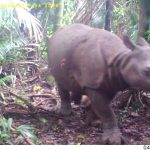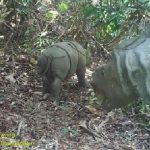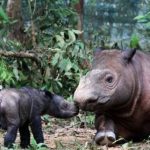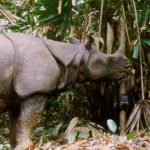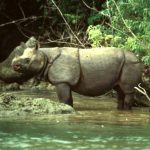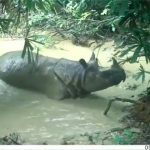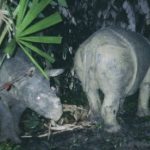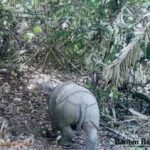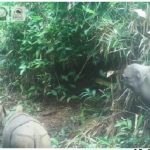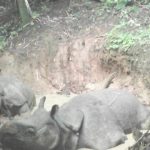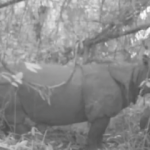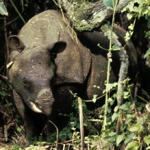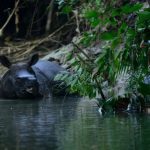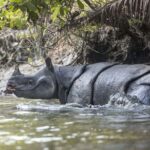Rhinoceros sondaicus
Javan rhinoceros
Badak Jawa
Javan rhinoceros
Badak Jawa
The decline of the Javan rhinoceros is attributed to poaching, primarily for their horns, which are highly valued in traditional Chinese medicine, fetching as much as US$30,000 per kg on the black market. As European presence in their range increased, trophy hunting also became a serious threat. Loss of habitat, especially as the result of wars, such as the Vietnam War, in Southeast Asia, has also contributed to the species’ decline and hindered recovery. The remaining range is within one nationally protected area, but the rhinos are still at risk from poachers, disease, and loss of genetic diversity leading to inbreeding depression.
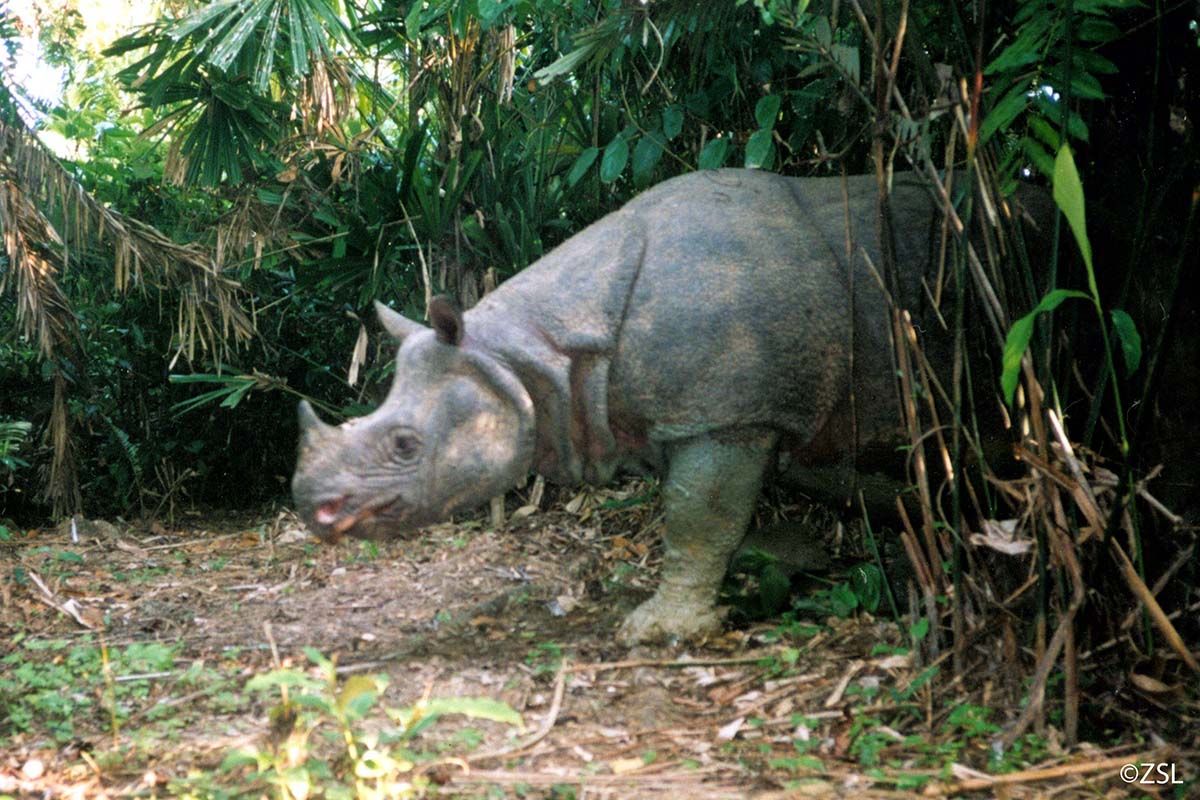 The Javan rhino can live around 30–45 years in the wild. It historically inhabited lowland rain forest, wet grasslands, and large floodplains. It is mostly solitary, except for courtship and offspring-rearing, though groups may occasionally congregate near wallows and salt licks. Aside from humans, adults have no predators in their range.
The Javan rhino can live around 30–45 years in the wild. It historically inhabited lowland rain forest, wet grasslands, and large floodplains. It is mostly solitary, except for courtship and offspring-rearing, though groups may occasionally congregate near wallows and salt licks. Aside from humans, adults have no predators in their range.
The Javan rhino usually avoids humans. Scientists and conservationists rarely study the animals directly due to their extreme rarity and the danger of interfering with such an endangered species. Researchers rely on camera traps and fecal samples to gauge health and behavior.
Consequently, the Javan rhino is the least studied of all rhino species. Two adult rhinos with their calves were filmed in a motion-triggered video released on 28 February 2011 by WWF and Indonesia’s National Park Authority, which proved it is still breeding in the wild.
In April 2012, the National Parks Authority released video showing 35 individual Javan rhinos, including mother/offspring pairs and courting adults. There are only 58 to 68 individuals left in the wild, and none in captivity, after the death of a male rhinoceros named Samson.
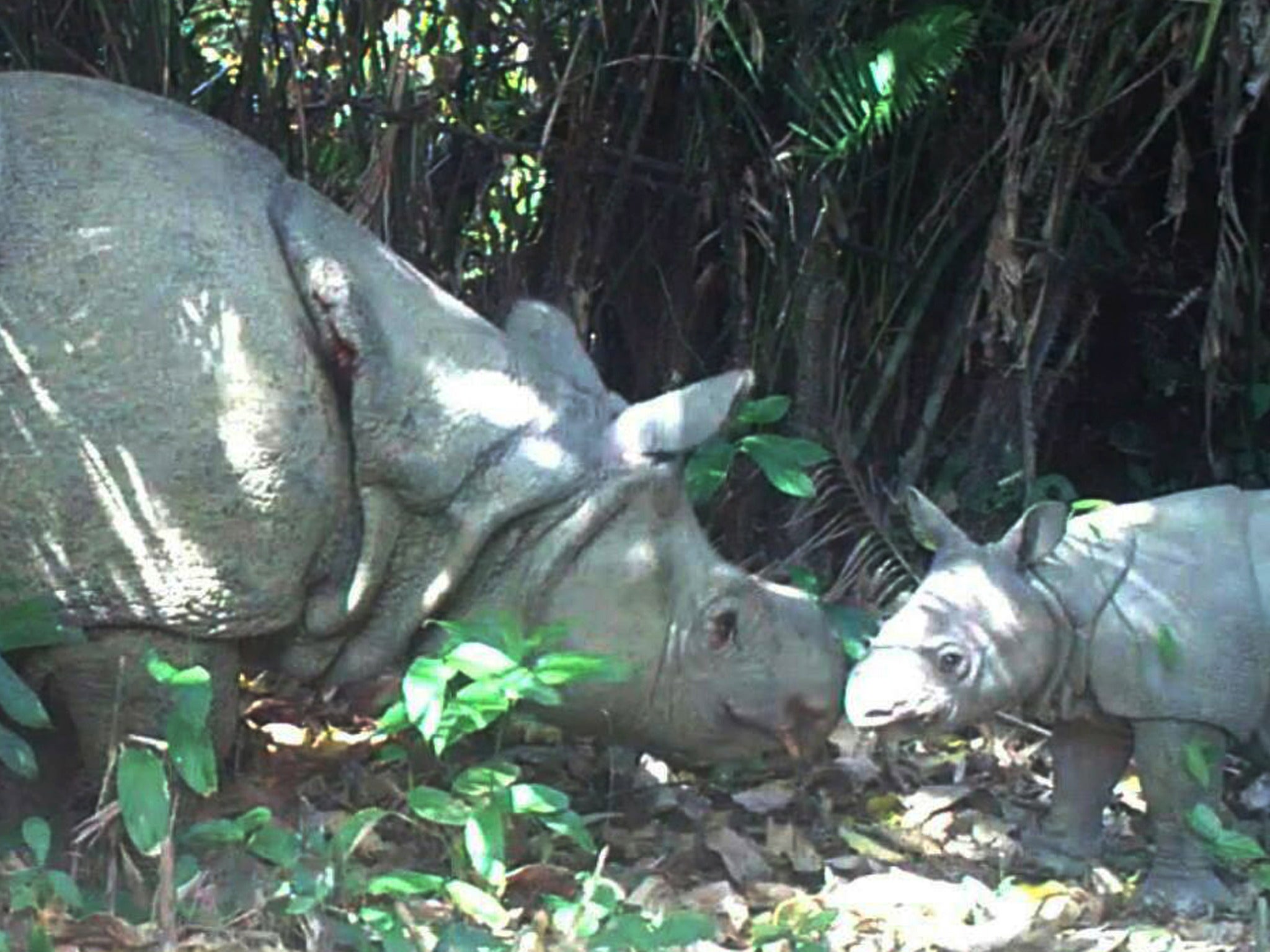 Samson died in April 2018 at 30 years of age, far younger than the species’ usual lifespan of 50 to 60 years, so DNA testing is being conducted to explore the cause of death, including the possibility of inbreeding degeneration.
Samson died in April 2018 at 30 years of age, far younger than the species’ usual lifespan of 50 to 60 years, so DNA testing is being conducted to explore the cause of death, including the possibility of inbreeding degeneration.
Etymology
The genus name Rhinoceros is a combination of the ancient Greek words ῥίς (ris) meaning ‘nose’ and κέρας (keras) meaning ‘horn of an animal’. sondaicus is derived from sunda, the biogeographical region that comprises the islands of Sumatra, Java, Borneo, and surrounding smaller islands.
The Javan rhino is also known as the lesser one-horned rhinoceros (in contrast with the greater one-horned rhinoceros, another name for the Indian rhino).
 Taxonomy
Taxonomy
Rhinoceros sondaicus was the scientific name used by Anselme Gaëtan Desmarest in 1822 for a rhinoceros from Java sent by Pierre-Médard Diard and Alfred Duvaucel to the National Museum of Natural History, France. In the 19th century, several zoological specimens of hornless rhinoceros were described:
Rhinoceros inermis proposed by René Lesson in 1838 was a female rhinoceros without horns shot in the Sundarbans; Rhinoceros nasalis and Rhinoceros floweri proposed by John Edward Gray in 1867 were two rhinoceros skulls from Borneo and one from Sumatra, respectively; and Rhinoceros annamiticus proposed by Pierre Marie Heude in 1892 was a specimen from Vietnam.
As of 2005, three Javan rhinoceros subspecies are considered valid taxa: R. s. sondaicus, the nominate subspecies, known as the Indonesian Javan rhinoceros; R. s. inermis, known as the Indian Javan rhinoceros or lesser Indian rhinoceros; and R. s. annamiticus, known as the Vietnamese Javan rhinoceros or Vietnamese rhinoceros.
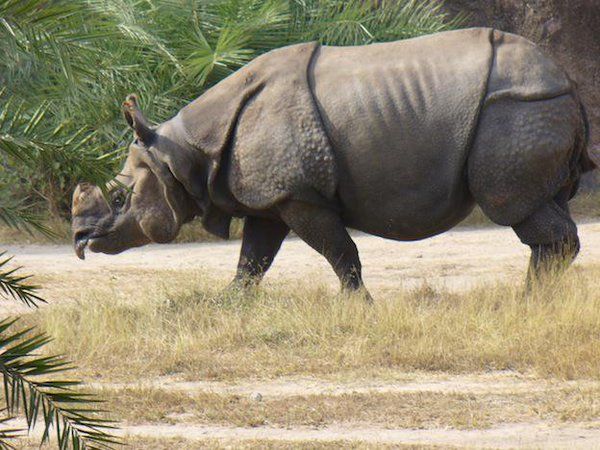 Behavior
Behavior
The Javan rhinoceros is a solitary animal with the exception of breeding pairs and mothers with calves. They sometimes congregate in small groups at salt licks and mud wallows. Wallowing in mud is a common behavior for all rhinos; the activity allows them to maintain cool body temperatures and helps prevent disease and parasite infestation.
The Javan rhinoceros does not generally dig its own mud wallows, preferring to use other animals’ wallows or naturally occurring pits, which it will use its horn to enlarge. Salt licks are also very important because of the essential nutrients the rhino receives from the salt. Male home ranges are larger at 12–20 km2 (4.6–7.7 sq mi)) compared to the female, which are around 3–14 km2 (1.2–5.4 sq mi)). Male territories overlap each other less than those of the female. It is not known if there are territorial fights.
Males mark their territories with dung piles and by urine spraying. Scrapes made by the feet in the ground and twisted saplings also seem to be used for communication. Members of other rhino species have a peculiar habit of defecating in massive rhino dung piles and then scraping their back feet in the dung. The Sumatran and Javan rhinos, while defecating in piles, do not engage in the scraping. This adaptation in behavior is thought to be ecological; in the wet forests of Java and Sumatra, the method may not be useful for spreading odors.
The Javan rhino is much less vocal than the Sumatran; very few Javan rhino vocalizations have ever been recorded. Adults have no known predators other than humans. The species, particularly in Vietnam, is skittish and retreats into dense forests whenever humans are near. Though a valuable trait from a survival standpoint, it has made the rhinos difficult to study.
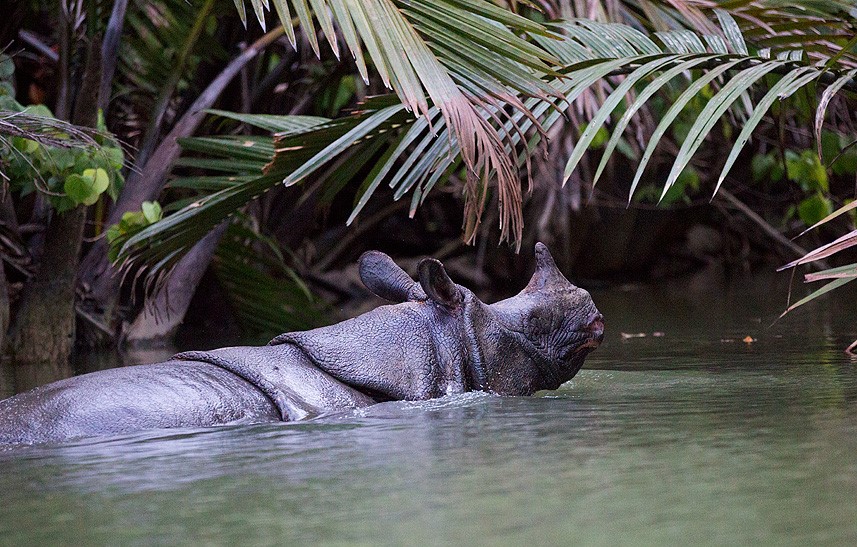 Nevertheless, when humans approach too closely, the Javan rhino becomes aggressive and will attack, stabbing with the incisors of its lower jaw while thrusting upward with its head. Its comparatively antisocial behavior may be a recent adaptation to population stresses; historical evidence suggests they, like other rhinos, were once more gregarious.
Nevertheless, when humans approach too closely, the Javan rhino becomes aggressive and will attack, stabbing with the incisors of its lower jaw while thrusting upward with its head. Its comparatively antisocial behavior may be a recent adaptation to population stresses; historical evidence suggests they, like other rhinos, were once more gregarious.
Diet
The Javan rhinoceros is herbivorous, eating diverse plant species, especially their shoots, twigs, young foliage and fallen fruit. Most of the plants favored by the species grow in sunny areas in forest clearings, shrubland and other vegetation types with no large trees. The rhino knocks down saplings to reach its food and grabs it with its prehensile upper lip. It is the most adaptable feeder of all the rhino species.
Currently, it is a pure browser, but probably once both browsed and grazed in its historical range. The rhino eats an estimated 50 kg (110 lb) of food daily. Like the Sumatran rhino, it needs salt in its diet. The salt licks common in its historical range do not exist in Ujung Kulon but the rhinos there have been observed drinking seawater, likely for the same nutritional need.
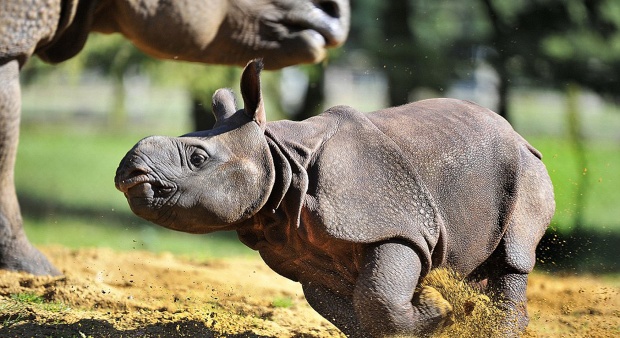 Distribution and Habitat
Distribution and Habitat
Even the most optimistic estimate suggests fewer than 100 Javan rhinos remain in the wild. They are considered one of the most endangered species in the world. The Javan rhinoceros is known to survive in only one place, the Ujung Kulon National Park on the western tip of Java.
The animal was once widespread from Assam and Bengal (where their range would have overlapped with both the Sumatran and Indian rhinos) eastward to Myanmar, Thailand, Cambodia, Laos, Vietnam, and southwards to the Malay Peninsula and the islands of Sumatra, Java, and possibly Borneo.
The Javan rhino primarily inhabits dense, lowland rain forests, grasslands, and reed beds with abundant rivers, large floodplains, or wet areas with many mud wallows. Although it historically preferred low-lying areas, the subspecies in Vietnam was pushed onto much higher ground (up to 2,000 m or 6,561 ft), probably because of human encroachment and poaching.
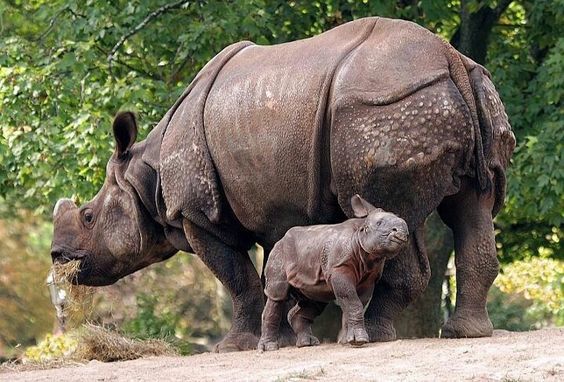 The range of the Javan rhinoceros has been shrinking for at least 3,000 years. Starting around 1000 BC, the northern range of the rhinoceros extended into China, but began moving southward at roughly 0.5 km (0.31 mi) per year, as human settlements increased in the region. It likely became locally extinct in India in the first decade of the 20th century.
The range of the Javan rhinoceros has been shrinking for at least 3,000 years. Starting around 1000 BC, the northern range of the rhinoceros extended into China, but began moving southward at roughly 0.5 km (0.31 mi) per year, as human settlements increased in the region. It likely became locally extinct in India in the first decade of the 20th century.
The Javan rhino was hunted to extinction on the Malay Peninsula by 1932. The last ones on Sumatra died out during World War II. They were extinct from Chittagong and the Sunderbans by the middle of the 20th century. By the end of the Vietnam War, the Vietnamese rhinoceros was believed extinct across all of mainland Asia.
Local hunters and woodcutters in Cambodia claim to have seen Javan rhinos in the Cardamom Mountains, but surveys of the area have failed to find any evidence of them. In the late 1980s, a small population was found in the Cat Tien area of Vietnam.
However, the last individual of that population was shot in 2010. A population may have existed on the island of Borneo, as well, though these specimens could have been the Sumatran rhinoceros, a small population of which still lives there.


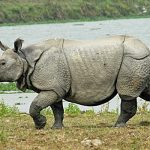
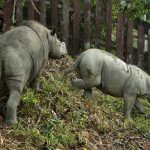

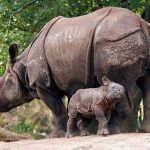
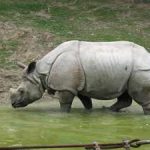

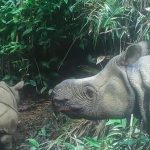
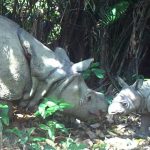
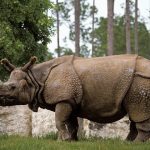
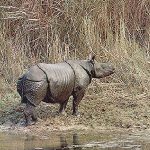
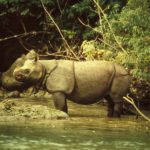
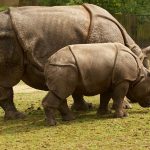
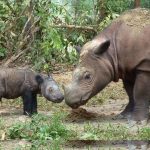
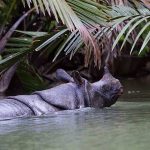
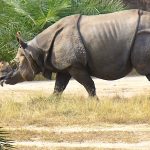

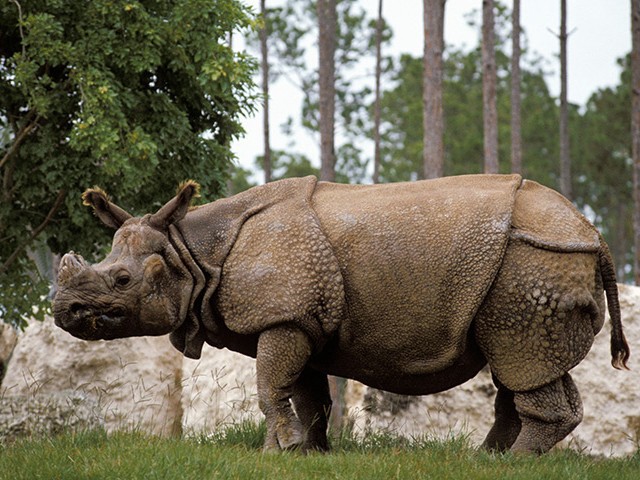 Conservation
Conservation
The main factor in the continued decline of the Javan rhinoceros population has been poaching for horns, a problem that affects all rhino species. The horns have been a traded commodity for more than 2,000 years in China, where they are believed to have healing properties. Historically, the rhinoceros’ hide was used to make armor for Chinese soldiers, and some local tribes in Vietnam believed the hide could be used to make an antidote for snake venom.
Because the rhinoceros’ range encompasses many areas of poverty, it has been difficult to convince local people not to kill a seemingly (otherwise) useless animal which could be sold for a large sum of money. When the Convention on International Trade in Endangered Species of Wild Fauna and Flora first went into effect in 1975, the Javan rhinoceros was placed under complete Appendix 1 protection.
All international trade in the Javan rhinoceros and products derived from it is illegal. Surveys of the rhinoceros horn black market have determined that Asian rhinoceros horn fetches a price as high as $30,000 per kg, three times the value of African rhinoceros horn.
As with many types of Asian and African megafauna, the Javan rhino was relentlessly hunted by trophy and big-game hunters for decades following the arrival of Europeans in its range. The rhinos being easy targets, this was as severe a contributor to its decline as was poaching for its horns. Such was the toll of big-game hunting that by the time the rhino’s plight was made known to the world, only the Javan and the (then unknown) Vietnamese populations remained.
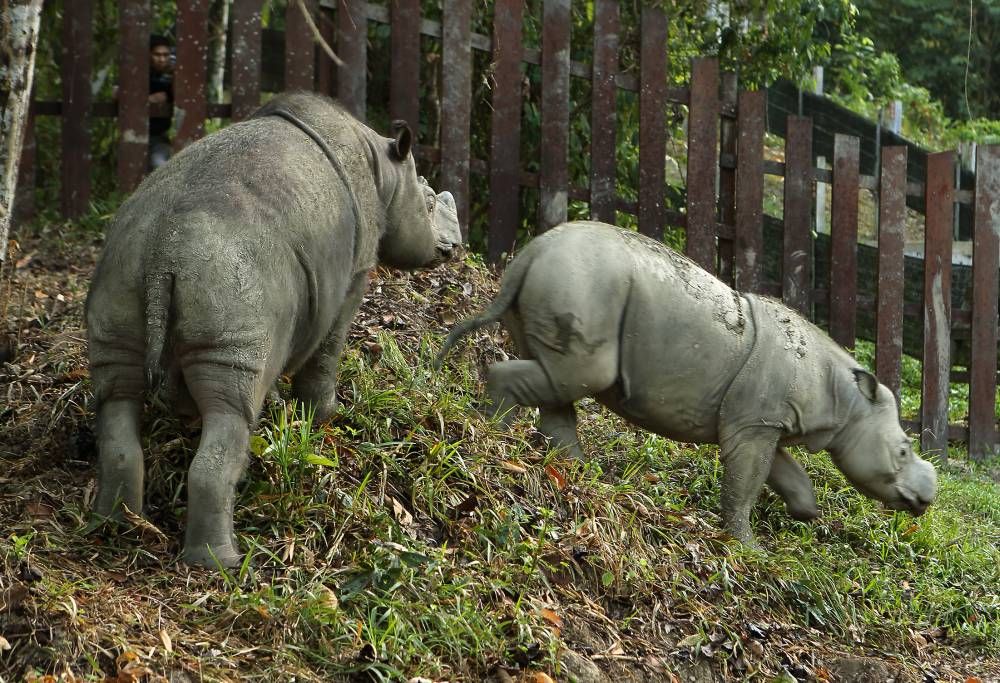 Loss of habitat because of agriculture has also contributed to its decline, though this is no longer as significant a factor because the rhinoceros only lives in one nationally protected park. Deteriorating habitats have hindered the recovery of rhino populations that fell victim to poaching.
Loss of habitat because of agriculture has also contributed to its decline, though this is no longer as significant a factor because the rhinoceros only lives in one nationally protected park. Deteriorating habitats have hindered the recovery of rhino populations that fell victim to poaching.
Even with all the conservation efforts, the prospects for their survival are grim. Because the population is restricted to one small area, they are very susceptible to disease and inbreeding depression. Conservation geneticists estimate a population of 100 rhinos would be needed to preserve the genetic diversity of this conservation-reliant species.
Ujung Kulon
The Ujung Kulon peninsula of Java was devastated by the eruption of Krakatoa in 1883. The Javan rhinoceros recolonized the peninsula after the event, but humans never returned in large numbers, thus creating a haven for wildlife. In 1931, as the Javan rhinoceros was on the brink of extinction in Sumatra, the government of the Dutch East Indies declared the rhino a legally protected species, which it has remained ever since.
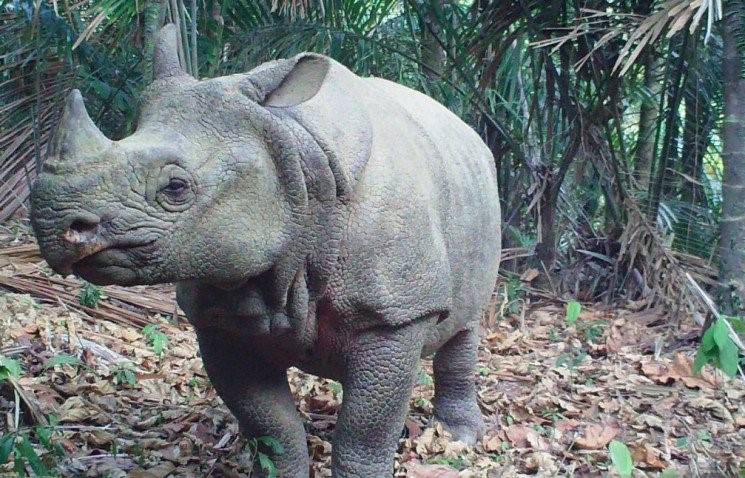 A census of the rhinos in Ujung Kulon was first conducted in 1967; only 25 animals were recorded. By 1980, that population had doubled and has remained steady, at about 50, ever since. Although the rhinos in Ujung Kulon have no natural predators, they have to compete for scarce resources with wild cattle, which may keep their numbers below the peninsula’s carrying capacity.
A census of the rhinos in Ujung Kulon was first conducted in 1967; only 25 animals were recorded. By 1980, that population had doubled and has remained steady, at about 50, ever since. Although the rhinos in Ujung Kulon have no natural predators, they have to compete for scarce resources with wild cattle, which may keep their numbers below the peninsula’s carrying capacity.
Ujung Kulon is managed by the Indonesian Ministry of Forestry. Evidence of at least four baby rhinos was discovered in 2006, the most ever documented for the species. With Ujung Kulon as the last resort of this species, all the Javan rhinos are in one location, an advantage over the Sumatran rhino which is dispersed in different, unconnected areas.
Poaching for their horns is also no longer as serious a threat as in the past, due to stricter international regulations on rhino horn, active protection efforts by local authorities, the rhinos’ elusiveness and Ujung Kulon’s remoteness. However, there are still obstacles to the species’ recovery. Being concentrated in such a relatively small area makes the species extremely susceptible to disease and tsunamis.
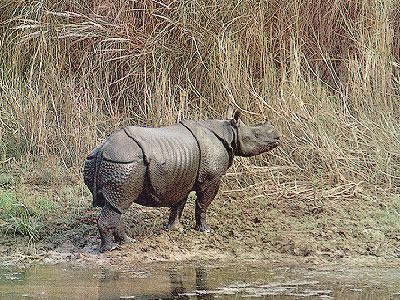 In Captivity
In Captivity
A Javan rhinoceros has not been exhibited in a zoo for over a century. In the 19th century, at least four rhinos were exhibited in Adelaide, Calcutta, and London. At least 22 Javan rhinos have been documented as having been kept in captivity; the true number is possibly greater, as the species was sometimes confused with the Indian rhinoceros.
The Javan rhinoceros never fared well in captivity. The oldest lived to be 20, about half the age that the rhinos can reach in the wild. No records are known of a captive rhino giving birth. The last captive Javan rhino died at the Adelaide Zoo in Australia in 1907, where the species was so little known that it had been exhibited as an Indian rhinoceros.
Threats
According to the World Wide Fund for Nature (WWF) the Javan rhino is the most threatened rhino species with only 68–74 remaining in Ujung Kulon National Park in Java, Indonesia. The WWF has listed several threats faced by the Javan rhino that result in its designation as “critically endangered”. One of those threats is its “reduced genetic diversity”, because the low number of existing Javan rhinos results in a low amount of genetic diversity and increased inbreeding, making it difficult for the Javan rhino to survive.
The WWF also identifies “natural disasters” as another threat faced by Javan rhinos, because Ujung Kulon National Park can be affected by tsunamis or the explosion of the nearby volcano Anak Krakatau, which potentially could wipe out the entire Javan rhino species. One such eruption and tsunami in 2018 wreaked heavy damage on the Pandeglang Regency, the district which contains Ujung Kulon National Park. However, the park and its rhino population were not significantly affected.

